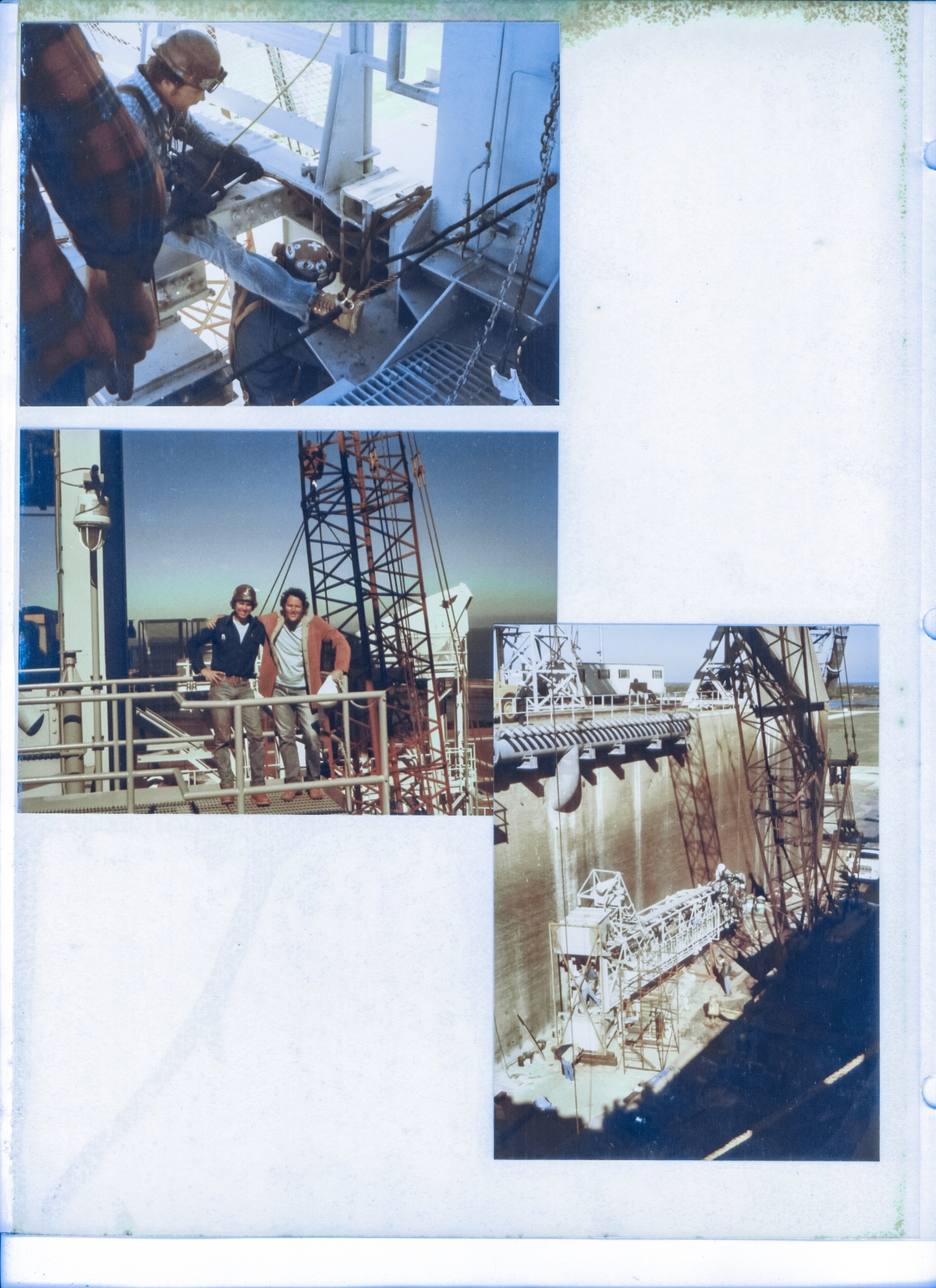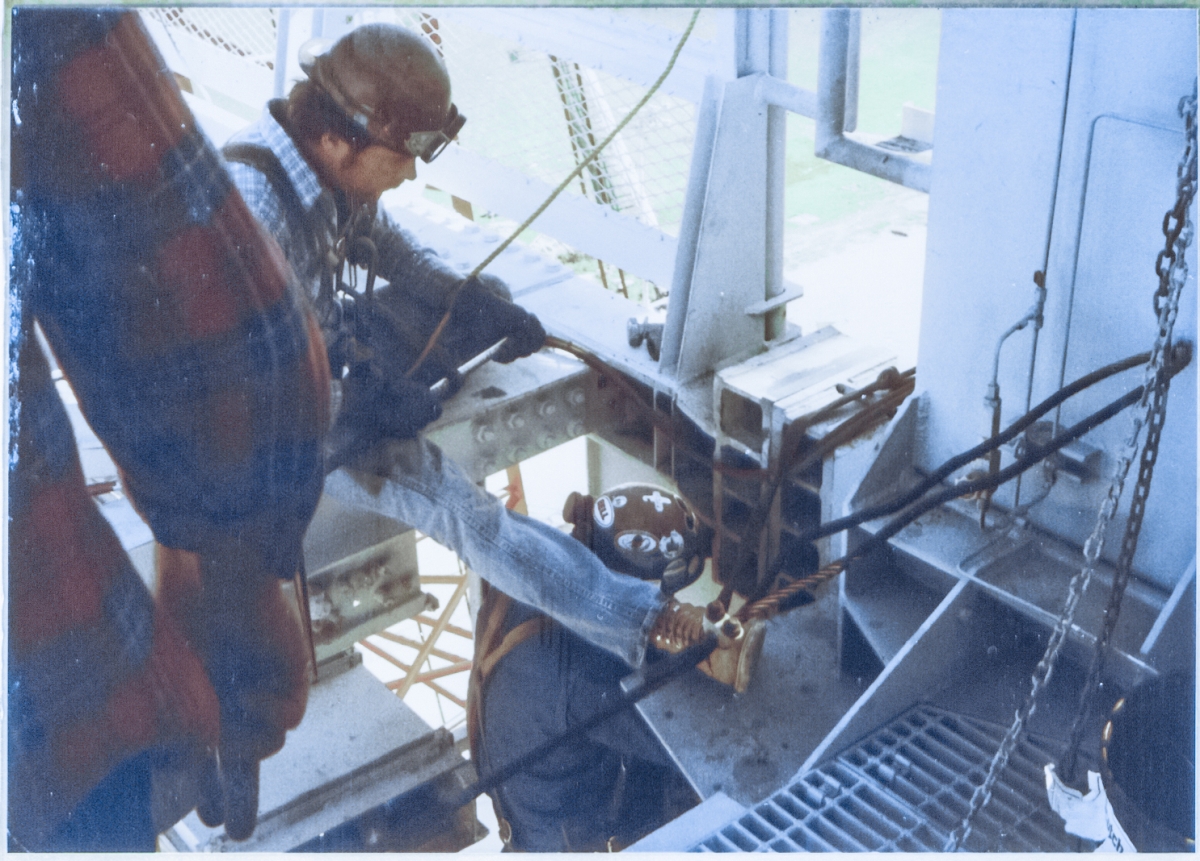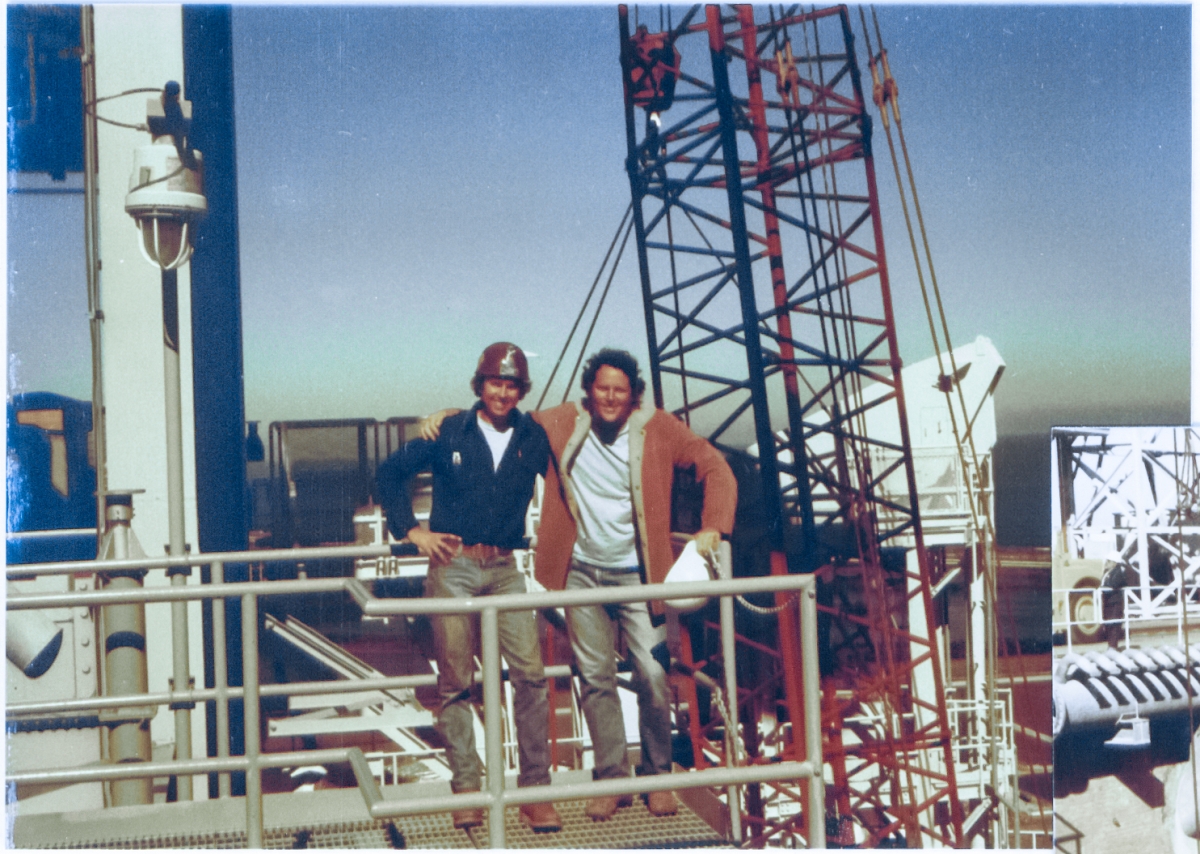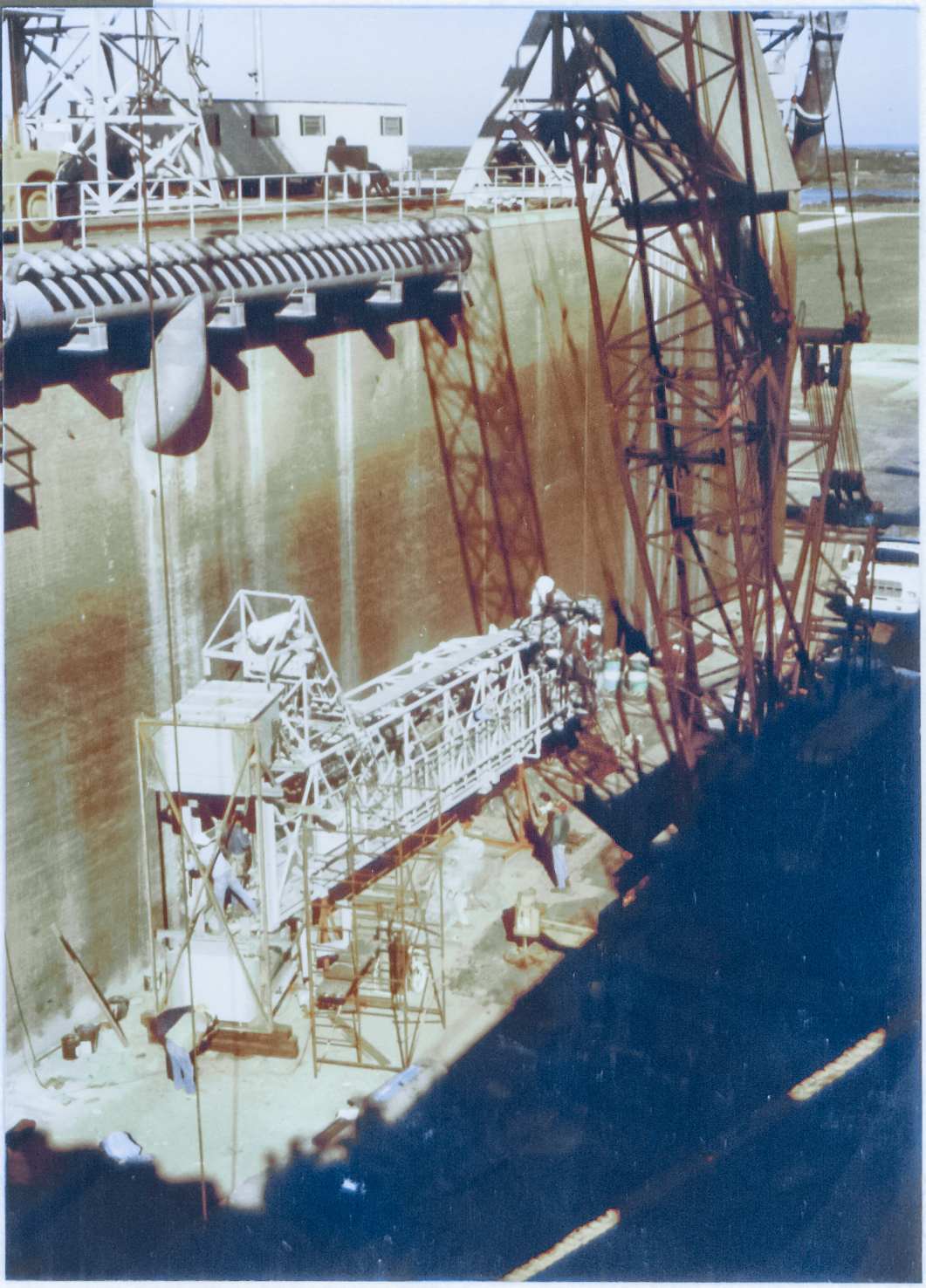Space Shuttle Launch Complex 39-B Construction Photos
Page 20
IAA Lift 3, Orbiter Access Arm in the Flame Trench
(Original Scan)
Intertank Access Arm Lift page 3
Fastening the IAA to the FSS.
Me and Steve Parker, who went on to do well in the Ironworker's Union International, if I was told arightly.
The Orbiter Access Arm, getting prepped down in the bottom of the north side of the Flame Trench.
Additional commentary below the image.

Top:
(Reduced)

Connectors, connecting.
And of course, just going by the looks of things, this one was a bitch to finish off.
The ironworker sitting high, with his leg outstretched and his boot on a gusset plate, is holding an oxyacetylene torch. Why? Why would something like that be needed to connect a pair of properly-designed steel objects together? The answer is that it would not, and should not, be needed.
Some damn thing was not built precisely like the original plans dictated it be built, and the alteration never made it into the final plans which were furnished to the contractor to allow him to accurately bid and then prosecute the work, and there's no telling what or where the issue is, but issue there must be, or otherwise we're not going to be taking all the time and effort to drag the torch kit half way up the goddamned FSS and then cut something off of something else.
But there he sits, and that's that.
My money is on the interfering object being a bit of Unistrut, but that's a complete guess. That said, despite the fact that during the entire time we worked on B Pad we were expressly forbidden from ever using, or, really, even thinking about, the use of Unistrut, the stuff was all over the place, anyway.
Cast your gaze over toward the right-hand edge of the frame, just a little bit below center. There's a length of dark wire rope which passes across the boot of our ironworker who's getting organized with the torch, where a wire-rope clip can be seen, fastening the doubled-back length of that wire rope to itself, creating a nice loop, which is stretched out pretty long, and over toward the right-hand end of that stretched-out loop of wire rope, you can see it crossing in front of a short piece of Unistrut, with its closed back side welded to the bland gray flatness of the FSS perimeter column, and its open front side engaged in holding up whatever it is that's keeping some tubing clamped firmly in place. That's pretty thin tubing there, and I have no idea what it might be, but it looks pretty light, whatever it is. GN2 purge, maybe, but I really do not know.
That piece of Unistrut may very well have been left over from Apollo-project days, as part of the LUT, but then again, maybe not. It might have been much more recent than that. Again, I really do not know.
But what I do know is that by the time we showed up, NASA had developed a great hatred for Unistrut on the pad, and although we weren't allowed to even speak its name, we would find it everywhere, and sometimes it would appear to be "active" and other times it would appear to have been abandoned, but at all times, if the damn thing was interfering with a connection, then, "Off with its head!" and away we'd go.
We were told that NASA hated it because it tended to rust. It was thin-wall, and was bent in a way that would trap water, and rotten pieces of Unistrut tacked on to the structure here and there were just part of everyday life on the pad, and nobody really ever gave it a thought. Unless it got in their way.
Ok, enough with rusted Unistrut knick-knacks, let's have a look at the structural connection itself.
It's the part of things immediately to the right of the lower ironworker's hard hat, that looks almost like a stack of cinder blocks. The left-hand stack of "cinder blocks" is an integral part of the IAA, and the right-hand stack of "cinder blocks" which is butted hard against the left-hand one, is an integral part of the FSS, and such is the power of simple arithmetic, geometry, and perhaps a pinch of equally-simple trigonometry, you can confidently bet all the money it might cost to employ a crew of ironworkers and a large crane, that when these two structural elements see each other for the first time, and come in contact for the first time, the fucking bolt-holes will line up correctly, and the bolts will pass through both sets of bolt-holes and permit nuts to be applied and torqued down, resulting in a single, stronger-than-holy-hell, object.
But, despite the marvels of simple mathematics (Pay attention to that shit in school, children, because even though the people teaching it to you have no real-world experience with it, and literally have no idea what good it's good for, right now, it will without the slightest doubt get used, some distant day into an opaquely-unknowable future, when without warning the wider-world will be coming at you with no end of surprises and opportunities that even a middling understanding of basic math will permit you to handle with speed, elegance, and overwhelming accuracy, such that you will achieve god-like status and standing with all of the lesser mortals surrounding you who cannot so much as figure their change due back on a transaction at the local mini market. That said, you may also count on the ones who can't even figure their own change to become jealous and begin fearing for their own tenuous positions, and then start in with all the underhanded smile-in-your-face bullshit that goes with devious attempts to stab you in the back and stir up trouble for you with the higher-ups. It's a fucking jungle out there. Never forget that, ok?) something funny is going on here.
This is not a normal structural connection.
Normal structural connections are not this complicated-looking. This thing looks almost as if somebody re-ran the stress calcs after the IAA had already been built, and discovered that the loads going through this connection were going to be greater than they initially figured. Maybe the original calculations were strictly static loads, and they went with that, until somebody asked "What happens when the exhaust from the left SRB hits this thing?" That kind of stuff happens far more often than you might imagine. Then again, maybe the business-end of the IAA was relooked-at and somebody discovered it was just about a foot too far away from the External Tank as-built, and it needed some spacers to get it all the way out there where it needed to be. Who knows? Whatever the hell it was that happened, it caused them to make some very difficult weldments out of one-inch steel plate, with five horizontal stiffener plates, welded to a second vertical backing-plate, across the expanse of the vertical plates that were to take the bolts that would make the actual connection, and they had to do it on both sides, IAA side and FSS side, of the connection. This thing just looks stupid, and I'm sure it was no end of fun for everybody to get their hands inside those fucking gaps between the stiffener plates and try to fish the bolts through the holes in the vertical connection plates, and god help you if there's any mismatch in hole locations and you might need to put a little force on the bolt to get it to slip all the way through, and then once that's done you have to figure out how to torque the sonofabitch properly, and apparently by hand, and this whole thing is just a monumental piece of shit.
But in the end, it worked. In the end, the IAA never fell off the tower, even during a launch. So... ...ok.
Look to the right of the ironworker's hand holding the torch hose and you can see a couple of the bolts they're going to have to be getting inside those ridiculously cramped spaces and torquing up. Structural bolts are a different beast, and they can be difficult to deal with in confined spaces. But here we are, and this is what we've got to work with, so I suppose we'll just have to work with it.
Middle:
(Reduced)

Steve Parker, another Good Man, and myself, and it looks like we'll be charged with rape and murder for fucking off and killing time. Oh well. Alas, I have no recollection of who it was that took this picture with my camera. Sigh.
Please notice the platform we're standing on.
It's the uppermost of the FSS/RSS crossover catwalks, out between the FSS proper and the Hinge Column, and we're at the 220' elevation. This photograph was taken from the corresponding RSS-half of the crossover catwalk, at the same elevation 220' and just beyond the the Hinge Column, over on the RSS side of things, and the Hinge Column (which is a great damn big monumental-sized thing) is barely out of view, just below us.
Look close at my left hand, resting on the handrail of that platform, and you'll see there's an open gap protected only by a couple of chains. Why?
The reason why is that when the RSS was rotated around into the mate position, this little platform would match up with the corresponding half of the crossover catwalk, coming over from the RSS, and the chains would be unhooked and you could then walk straightaway across from the FSS to the RSS via the complete catwalk that this pair of matched platforms constituted. But with the RSS rotated back to the de-mate position, this platform lead nowhere, and on the other side of those chains was a sheer drop of 170 feet to where your crumpled body would be laying on the pad deck, should you to take that drop. So you always had to pay attention to where you were, to where you were going, and to where, where you were going might have gone, 'cause sometimes where you were going wasn't there anymore, and you could get into trouble when it wasn't there. There were other FSS/RSS crossover catwalks made up of sets of similarly matched platforms at lower elevations, and you really had to watch your step when you were walking around up there. One wrong turn, one little moment of inattention, one little moment of looking over your shoulder to see who called your name, one little moment of scanning the blueprints you were carrying with you as you went to go look at some fucked up problem or other, and.....
Look at those chains again, goddamnit. Look at where the catenary of the top chain is. It's well below hip level, and if you happened to blunder into it, it would momentarily give in the direction you were traveling in, before suddenly jerking steel-rigid taut, and the result of that would be you, well overbalanced with the majority of your weight and inertia above the top of that motherfucking safety chain, center of mass extended out beyond the end of the steel bar grating, and, just for good measure, a second chain below to prevent you from reflexively throwing a leg and foot far enough out to catch your incipient fall (nevermind there's no more fucking platform out there for a foot to land on anyway), resulting in your being flipped over, out into the dreadfully empty space just beyond the end of the platform, .....gone.
How goddamned hard would it have been to pull the location of that miserable fucking chain back in from the extreme death end of the platform far enough to allow you a bit of additional platform to get flipped over on top of if you hit it wrong? But no. Not gonna happen. What it was they were afraid of in not doing that, I never learned, and I'm guessing there was no fucking reason. They just did it because it looked like the right thing to do, it looked good on the drawing, and none of those idiots ever even considered the physics of somebody actually hitting their little piece of safety theater the wrong way. I always hated those fucking "safety" chains, and could never understand 1.) why they were designed and built the way they were, as opposed to an actual working physical barrier of some kind, and 2.) why they never lost anybody over the end of one of them. (We never did, but other people, and other agencies, other jobs, other programs, well, I simply do not know.) So in the end, all the safety guys who designed and implemented them wound up looking good, and I'm sure they all got the recommendations, promotions, and pay raises that they all so well and truly deserved. The assholes.
As I earlier mentioned, this particular platform was up at the 220' level, and provided access to the roof of the RSS above the PCR, up in the area of the RCS room, and the Hoist Equipment Room. Nice view from up here, all the way around.
Also, look to our left, almost to the edge of the frame, and you'll notice a bit of a post, slightly darker in shade than the FSS perimeter column that it's not quite centered in front of. The top of this post comes up to about chest level on Steve and me, and has a sort of "fixture" up on its top, ending in a nice flat round horizontal plate of steel. This thing is a camera mount, and it holds up an OTV camera (not installed yet). They had them all over the damned place on both pads. Now that you know what they look like, maybe poke through these images again, to see if you can find any more of them. This one's on a fairly tall post. Some of them were just the "fixture" part, attached to other things. It all depended on what it was that they wanted to see, and where they had to mount the camera to see it.
And oh god, this just reminded me of a goofy story regarding these things.
Operational Television cameras, were part of a system that monitored the whole place in real time using closed-circuit TV surveillance cameras. Turns out it's kind of hard to find decent pictures of them in their natural habitat. But here's one I found (which is also a really good picture of what it looks like as the RSS closes in on the Shuttle, as it's being rotated around into the mate position). Zoom in, full size, or even larger, and get a look at 'em, and in particular, the lowest one with an arrow pointing to it, as it is quite typical of the breed, and is exactly what the following story is referring to, ok?
Ok.
Anyway, this stuff was being installed on the towers, by others, and at some point the system went live, and we were all warned to "Smile, you're on candid camera," and that was that.
Ok, fine. Whatever.
Well, it turns out that despite their relative obscurity on the internet nowadays, those Operational Television Cameras were really easy to find if you were walking around on the tower looking for them, and since they were intended to be serviced by normal people in normal ways, they were really easy to get to.
And one fine day, one of the ironworkers took it into his mind that he'd have a bit of fun with this stuff, and embarked upon a little journey across the length and breadth of the RSS looking for these sonofabitches, and then came up from behind each one of them unseen and surreptitiously reached around and slapped some tape over the front end of it, thereby blinding it.
Somewhere, down in some darkened control room lined with video monitors, probably over in the Launch Control Center, the lights began to go out on their TV screens.
And since the tower is large, and our perpetrator wasn't in any kind of hurry while doing what he was doing with his roll of tape, things proceeded quite slowly down in that darkened control room somewhere, one camera at a time, until finally somebody realized that they were in the process of somehow losing their entire system, in slow motion, and they must have blown some kind of whistle and action was taken.
Technicians and perhaps a security operative or two were dispatched to the pad, and they immediately discovered that all of their goddamned OTV cameras had been taped up on their front ends, and matters were put right, straightaway, and in the end all was well, and so far as I know, none of the culprits were ever fingered, nor were they ever brought to justice.
But I've always wondered what it must have been like, down in that darkened control room, as things crept slowly forward, one camera at a time, until realization finally dawned on them that something was afoot.
I'm sure I'll never know.
Bottom Right:
(Full-size)

That's the Orbiter Access Arm down in the bottom of the flame trench, getting prepped for its eventual lift to its final location up on the FSS. The OAA was the last thing solidly attached to the earth that the astronauts touched, prior to entering the Space Shuttle on launch day. For some reason, that always gave me a kind of funny feeling about the OAA, and made it noticeably different from everything else up on the tower. I had an altogether different level of respect for that goddamned OAA than I had for anything else out there, and I could feel it whenever I got near or on that thing.
The people that flew in the goddamned Space Shuttle were hard fucking core, and as bad as any bad-ass you'll ever cross paths with in your life. These people knew that the fucking Shuttle might not work, and a couple of times it didn't, and they placed their own physical asses on the line every time they got inside of that motherfucker and felt the engines light up, down there beneath them.
It flat fucking does not get any more hard-core than that. Period.
Return to 16streets.comACRONYMS LOOK-UP PAGEMaybe try to email me? |